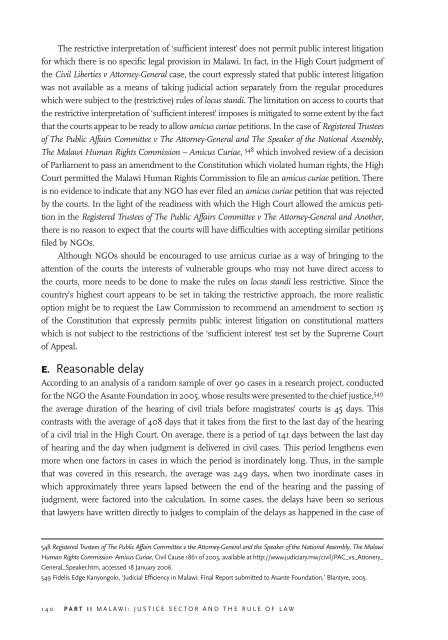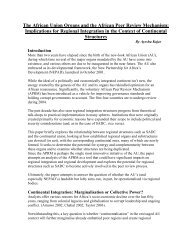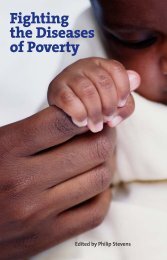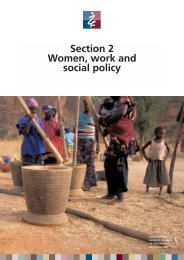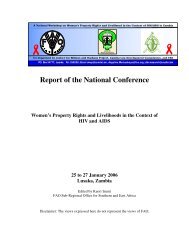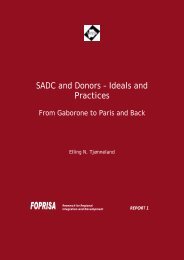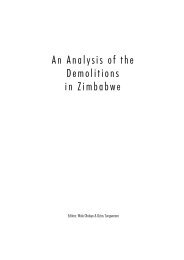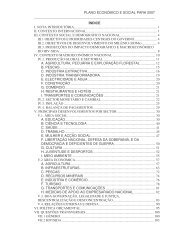Justice Sector and the Rule of Law - AfriMAP
Justice Sector and the Rule of Law - AfriMAP
Justice Sector and the Rule of Law - AfriMAP
Create successful ePaper yourself
Turn your PDF publications into a flip-book with our unique Google optimized e-Paper software.
The restrictive interpretation <strong>of</strong> ‘sufficient interest’ does not permit public interest litigationfor which <strong>the</strong>re is no specific legal provision in Malawi. In fact, in <strong>the</strong> High Court judgment <strong>of</strong><strong>the</strong> Civil Liberties v Attorney-General case, <strong>the</strong> court expressly stated that public interest litigationwas not available as a means <strong>of</strong> taking judicial action separately from <strong>the</strong> regular procedureswhich were subject to <strong>the</strong> (restrictive) rules <strong>of</strong> locus st<strong>and</strong>i. The limitation on access to courts that<strong>the</strong> restrictive interpretation <strong>of</strong> ‘sufficient interest’ imposes is mitigated to some extent by <strong>the</strong> factthat <strong>the</strong> courts appear to be ready to allow amicus curiae petitions. In <strong>the</strong> case <strong>of</strong> Registered Trustees<strong>of</strong> The Public Affairs Committee v The Attorney-General <strong>and</strong> The Speaker <strong>of</strong> <strong>the</strong> National Assembly,The Malawi Human Rights Commission – Amicus Curiae, 548 which involved review <strong>of</strong> a decision<strong>of</strong> Parliament to pass an amendment to <strong>the</strong> Constitution which violated human rights, <strong>the</strong> HighCourt permitted <strong>the</strong> Malawi Human Rights Commission to file an amicus curiae petition. Thereis no evidence to indicate that any NGO has ever filed an amicus curiae petition that was rejectedby <strong>the</strong> courts. In <strong>the</strong> light <strong>of</strong> <strong>the</strong> readiness with which <strong>the</strong> High Court allowed <strong>the</strong> amicus petitionin <strong>the</strong> Registered Trustees <strong>of</strong> The Public Affairs Committee v The Attorney-General <strong>and</strong> Ano<strong>the</strong>r,<strong>the</strong>re is no reason to expect that <strong>the</strong> courts will have difficulties with accepting similar petitionsfiled by NGOs.Although NGOs should be encouraged to use amicus curiae as a way <strong>of</strong> bringing to <strong>the</strong>attention <strong>of</strong> <strong>the</strong> courts <strong>the</strong> interests <strong>of</strong> vulnerable groups who may not have direct access to<strong>the</strong> courts, more needs to be done to make <strong>the</strong> rules on locus st<strong>and</strong>i less restrictive. Since <strong>the</strong>country’s highest court appears to be set in taking <strong>the</strong> restrictive approach, <strong>the</strong> more realisticoption might be to request <strong>the</strong> <strong>Law</strong> Commission to recommend an amendment to section 15<strong>of</strong> <strong>the</strong> Constitution that expressly permits public interest litigation on constitutional matterswhich is not subject to <strong>the</strong> restrictions <strong>of</strong> <strong>the</strong> ‘sufficient interest’ test set by <strong>the</strong> Supreme Court<strong>of</strong> Appeal. According to an analysis <strong>of</strong> a r<strong>and</strong>om sample <strong>of</strong> over 90 cases in a research project, conductedfor <strong>the</strong> NGO <strong>the</strong> Asante Foundation in 2005, whose results were presented to <strong>the</strong> chief justice, 549<strong>the</strong> average duration <strong>of</strong> <strong>the</strong> hearing <strong>of</strong> civil trials before magistrates’ courts is 45 days. Thiscontrasts with <strong>the</strong> average <strong>of</strong> 408 days that it takes from <strong>the</strong> first to <strong>the</strong> last day <strong>of</strong> <strong>the</strong> hearing<strong>of</strong> a civil trial in <strong>the</strong> High Court. On average, <strong>the</strong>re is a period <strong>of</strong> 141 days between <strong>the</strong> last day<strong>of</strong> hearing <strong>and</strong> <strong>the</strong> day when judgment is delivered in civil cases. This period leng<strong>the</strong>ns evenmore when one factors in cases in which <strong>the</strong> period is inordinately long. Thus, in <strong>the</strong> samplethat was covered in this research, <strong>the</strong> average was 249 days, when two inordinate cases inwhich approximately three years lapsed between <strong>the</strong> end <strong>of</strong> <strong>the</strong> hearing <strong>and</strong> <strong>the</strong> passing <strong>of</strong>judgment, were factored into <strong>the</strong> calculation. In some cases, <strong>the</strong> delays have been so seriousthat lawyers have written directly to judges to complain <strong>of</strong> <strong>the</strong> delays as happened in <strong>the</strong> case <strong>of</strong>


